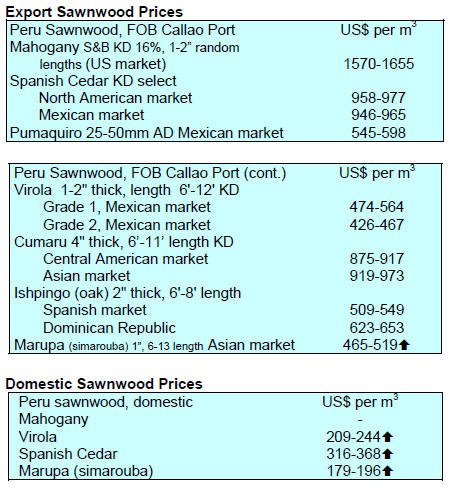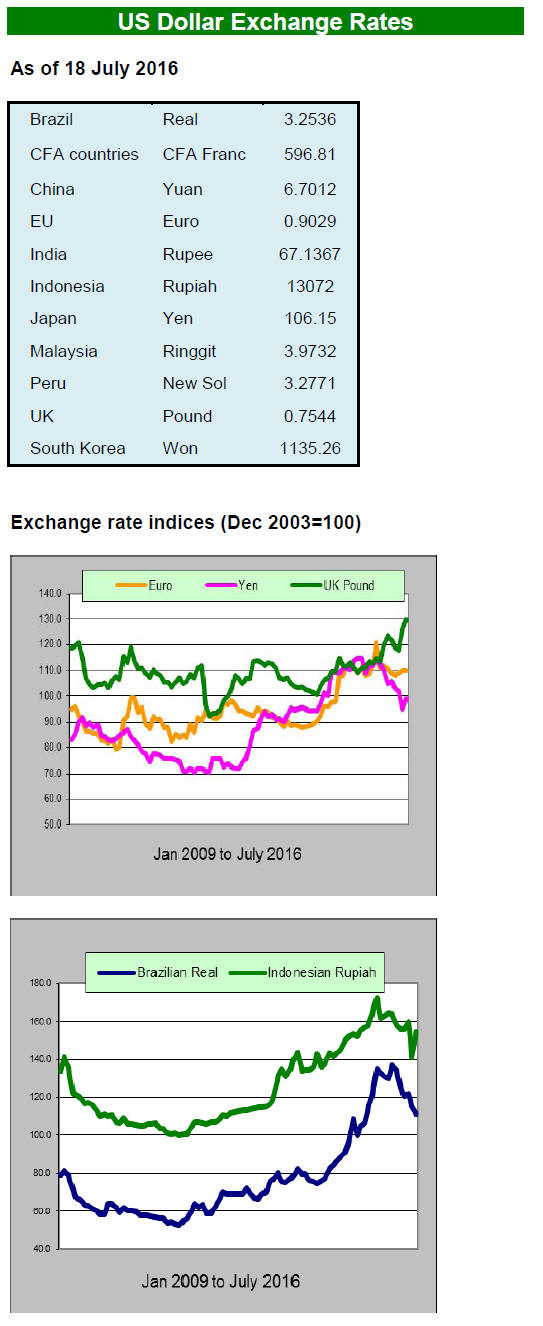2. GHANA
Encouraging May export figures
The export of Ghana*s wood products in May 2016
yielded euro 18,755,766 from a volume of 33,348 cu.m
which represents an increases of 37% in value and 23% in
volume compared to exports in May 2015.
In terms of species the top were teak, rosewood, wawa,
papao/apa and ceiba and exports went to 39 different
markets with the top 5 being India, China, Vietnam,
United States of America and Germany.
Wood product exports to African countries included
plywood (overland transport), sliced veneer, air and kiln
dry sawnwood, rotary veneer and mouldings. Major
destinations included Egypt, South Africa, Morocco; with
the ECOWAS sub-region market taking the largest share
of 16,490 cu.m valued at euro 4.92million.
Despite the better export performance in May, Ghana*s
overland wood exports during the first 5 months of the
year suffered some setback as sliced veneer, sawnwood
and plywood exports were down year on year.
Plywood exports were particularly badly down.
Nigeria,
which had been the leading importer of Ghana*s plywood,
slipped to the second ranked importer after Niger, with
Burkina Faso and Togo ranked 3rd and 4th.
The drop in Nigeria*s plywood import has been attributed
to the foreign exchange controls introduced by Nigeria*s
Central Bank.
In the first 5 months the major market destination for
Ghana*s wood products were; Asia/Far East 113,671cu.m
(71%); Europe 18,972 cu.m (12%); Africa 19,786 cu.m
(12%); America 5,510 cu.m (3%) and Middle East
countries 2,953 cu.m (2%).
For more see:
http://www.fcghana.org/userfiles/files/TIDD%20Export%20Rep
ort/EXPORT%20OF%20TIMBER%20AND%20WOOD%20PR
ODUCTS%20REPORT%20FOR%20MAY%202016.pdf
Business executives discuss impact of Brexit
Business executives have met to discuss the impact of
Brexit on Ghana*s international trade.
Dubbed &Ghana Business Day*, the meeting brought
together high-level business executives, industrialists,
policy makers, the diplomatic community and
manufacturers.
Key speakers included the Minister for Trade and
Industry, Mr. Ekwow Spio-Garbrah, Bristish High
Commissioner to Ghana 每 Jon Benjamin and President of
the Association of Ghana Industries James Asare-Adjei.
The Bank of Ghana has warned that Britain*s exit from the
European Union could negatively impact Ghana*s external
trade., foreign investment and exchange rates. The Bank
also pointed out that Ghana*s strong trade relations with
both the EU and the UK could be affected as Ghana may
lose some budgetary support from the EU.
Recent statistics show that Ghana is currently the UK*s
fifth largest trade partner in Sub-Saharan Africa. For
Ghanaian exporters, including timber companies, Brexit
has created uncertainty which coupled with liquidity
problems, high interest rates and the unstable power
situation is undermining confidence in the timber sector.
Forestry Master Plan and plantation strategy released
The Ghana Forestry Commission website has made
available the Ghana Forestry Development Master Plan
(2016-2036).
See:
http://www.fcghana.org/userfiles/files/MLNR/FDMP_June%201
5%20Final_draft.pdf
The preamble says ※This plan has taken into full account
the need to improve the state of the environment, whilst
addressing the complexities of land and tree tenure and the
importance of appropriate and efficient land use.
Within the framework of the 40-year national development
blue print a 20-year Ghana Forestry Development Master
Plan has been formulated.
This master plan is the product of consultative processes
involving engagements with experts and technocrats in the
forestry sector, traditional authorities and landowners,
development partners, forest fringe communities, policy
makers and legislators.
The vision, goal, and objectives of the Forestry
Development Master Plan (FDMP) reflect the national
development agenda, the National Climate Change Action
Plan, Sustainable Development Goals of the United
Nations and the on-going sector activities.
The plan seeks to contribute to reducing Green House Gas
(GHG) emissions from deforestation and forest
degradation, climate and temperature regulation,
sustainable supply of timber and wood fuels, reducing
poverty and helping to conserve biodiversity.
The full implementation of the forestry development
master plan will witness a structural transformation of the
forestry sector including the industries and institutions.
The plan also provides for financial intermediation and
incentive mechanisms for natural forest management,
timber plantation development, plant and machinery
development for tertiary processing activities and micro
and small wood processing enterprises.§ Plantation
development is an integral part of the long term plan and a
specific strategy has been developed for the period 2016-
40.
The strategy is available on the GFC website and outlines
plans to restore degraded landscapes through the
development of commercial forest plantations, smallholder
plantations, enrichment planting of degraded forests and to
provide support for the incorporation of trees within
farming systems.
The document says ※During the Strategy period (2016 -
2040), it is expected that an estimated average annual rate
of 25,000 ha of forest plantations (i.e. 10,000 ha by public
sector, public-private partnerships, public每community
collaborations; and 15,000 ha by the private sector) will be
established.
It is expected that an annual average area of 5,000 ha of
under-stocked 2 and degraded forest reserves and
community forests will be enriched using high value
indigenous tree species over a 20-year period.§
For more see:
http://www.fcghana.org/userfiles/files/Plantation%20Annual%20
Report/Ghana%20Forest%20Plantation%20Strategy%20(2016%
20-%202040).pdf
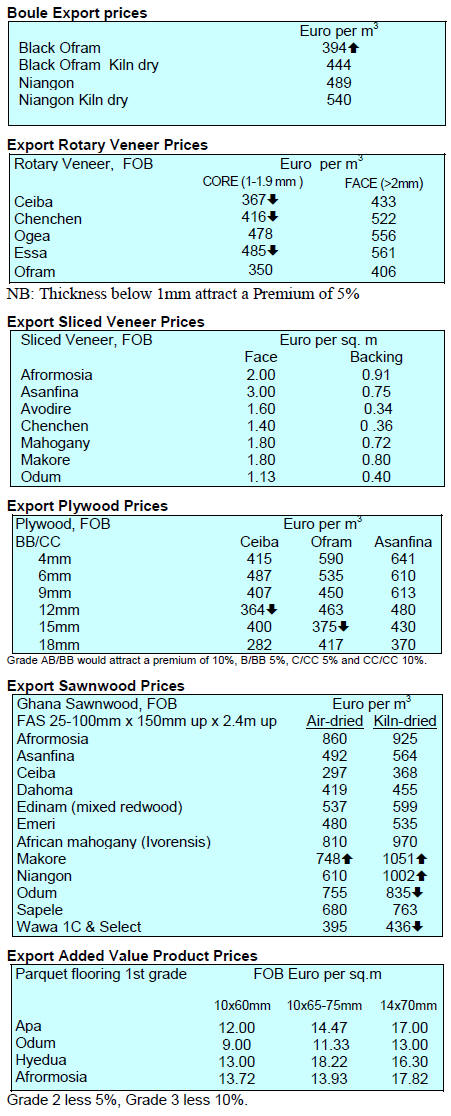
3. MALAYSIA
Exports to get a boost from interest rate
cut
In a surprise move, the central bank, Bank Negara
Malaysia (BNM) lowered its policy rate to 3%, the first
reduction since 2009 citing heightened risks to the global
economy. This change should mean the commercial banks
will lower lending and saving rates.
Local observers suggest the BNM rate change was
linked
to the ringgit exchange rate and that the cut in rates was
aimed at weakening the ringgit to boost exports.
Implementation of import regulation postponed
The Malaysian Timber Industry Board (MTIB) has
announced that full implementation of the timber import
legality regulations under the domestic Timber Legality
Assurance System (TLAS) will be postponed until January
2017. From January 2017 importers will be required to
verify the legality of imported logs, baulks and plywood.
Importers have been advised to secure legality verification
for wood products from producing countries especially for
products which will be processed for export.
See:
http://www.mtib.gov.my/index.php?option=com_content&view=
article&id=2299%3Aimport-legality-regulation-under-timberlegality-
assurance-system-tlas-&catid=1%3Ahighlights&lang=en
Opportunities in bio-prospecting 每 native knowledge to
be tapped
Sarawak has taken its research of the State*s biodiversity
to a new level with the establishment of an Integrated
Biodiversity Research facility in the Sarawak Biodiversity
Centre (SBC).
Sarawak*s Chief Minister, Adenan Satem, said as the
research progresses new economic opportunities may
emerge through bio-prospecting. The aim is to have local
communities work with the new centre to pass on
traditional knowledge and experience.
At the moment communities in the Bario highlands are
working with SBC to explore the possibility of
commercialising LitSara essential oil.
Market volatility and economic uncertainty jar markets
Wood product exports from Sarawak in the first half of
this year fell 3.5 % to RM3.09 billion compared to the
same period in 2015. Analysts point to market volatility
and economic uncertainty in major markets such as Japan,
India, Taiwan P.o.C and China as behind the decline.
Sabah export update
The value of Sabah*s wood product exports between
January and May 2016 totalled RM 659.94 million, almost
the same as the value of exports in the same five month
period last year.
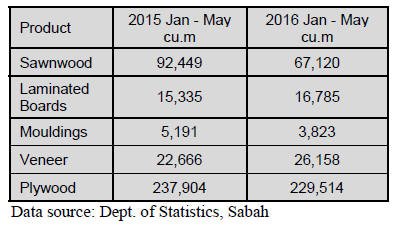
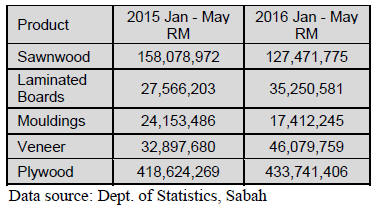
4. INDONESIA
Saudi Arabi to import gaharu
Importers in Saudi Arabia have placed a long term order
for Indonesian gahuru, internationally known as
agarwood. Agarwood forms in Aquilaria and Gyrinops,
both large tropical trees found throughout SE Asia, when
the trees become infected with a mould.
Since 1995 Aquilaria malaccensis, the main source for
gahura has been listed in Appendix II of CITES and in
2004 all Aquilaria species were listed in Appendix II.
Importers in Saudi Arabia have apparently contracted for
100 tonnes of Indonesian gaharu wood to be supplied over
the course of 12 months. Indonesian exports of gaharu for
this year to June were around 10 tonnes.
Moratorium on land clearing for palm oil to impact log
supply
The Indonesian government will introduce a five-year
moratorium on new palm oil concessions as part of the
country's effort to reduce the negative impact of land
clearing on the environment.
Last year the government extended the 2011 moratorium
on peatland clearing for plantations.
Darmin Nasution, Coordinating Minister for
Economic Affairs, said the government will have an
integrated plan that harmonises all concessions maps to
ensure that the new regulations do not overlap with
existing regulations in the mining, agriculture and
infrastructure development sectors.
A recent report from King*s College London and the
Center for International Forestry Research (CIFOR), says
the October 2015 forest fires in Sumatra and Kalimantan
released some 11.3 million tons of carbon each day (a
figure that exceeded the daily carbon emissions in the
European Union).
Traditionally slash-and-burn practices are used to clear
land for plantations after commercial logs are extracted.
See:
http://www.cifor.org/press-releases/carbon-emissions-2015-firessoutheast-
asia-greatest-since-1997-new-study/
Tax amnesty could boost growth
The Asian Development Bank (ADB) has maintained its
2016 growth projection for the Indonesian economy at
5.2%.
Growth will be driven by private consumption says the
ADB but some domestic and global risks remain. In
related news Bank Indonesia Deputy Governor, Perry
Warjiyo, has said he was optimistic that the tax amnesty
law would provide a boost to growth later in the year and
this should become more apparent in 2107.
Perry expressed the view that off-shore funds repatriated
under the tax amnesty deal will improve liquidity, allow
for a lowering of interest rates and stabilise the rupiah
exchange rate.
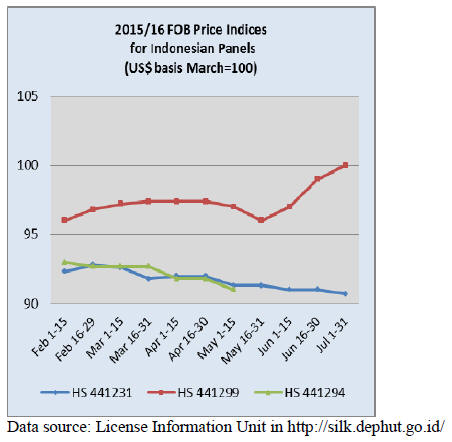
5. MYANMAR
First mill closure after logging
suspension
The first casualty of the suspension of logging has
emerged as a veneer mill in Myeik, a town in the southern
part of Myanmar. The mill has ceased production and the
CEO said milling would resume if raw materials become
available. Analysts comment that the mill was aware of
the likelihood of a logging suspension so should have
secured stocks to allow production to be maintained.
Tough to support unemployed elephants
Log haulage in Myanmar relies on elephants in many areas
and with the suspension of harvesting the owners of the
elephants are finding it hard to pay for food for their
animals. Elephants eat around 200 kg of foods every day
and securing food is now a problem.
The Myanma Timber Enterprise (MTE) has about 3,000
elephants while private sector enterprises have a further
2,000. According to researchers working elephants in
Myanmar can live for up to 40 years while the life span of
zoo elephants is around half that of working elephants.
Is there a place for private sector harvesting
when
logging suspension lifted?
For fiscal 2017-18 after the one-year suspension harvest
levels will be set at 320,000 Hoppus tons, about half the
production in 2015-16. In fiscal 2017-18 the teak harvest
will be around 15,000 Hoppus tons out of the total for the
year.
The domestic media have quoted U Myo Min, Deputy
Director of the Forest Department, as saying that private
logging companies will not be allowed to harvest logs as
the MTE will need to utilise its own resources for
harvesting. Prior to the log export ban MTE had subcontracted
some harvesting to private companies when
harvests were beyond the capacity of the MTE.
China - biggest investor in Thilawah Special Economic
Zone
The first phase of Thilawah Special Economic Zone which
started in 2014 has attracted around US$760 million in
investment. In the first phase, 73 enterprises from 16
countries were involved with companies in China
investing most followed by Singapore, Thailand, Hong
Kong, United Kingdom, Korea, Malaysia, Netherlands and
Vietnam.
Recently the Myanmar Investment Commission
announced business excluded from foreign investors and
the management of natural forests is one. There are
growing calls from domestic industry for some protection
of local sawmills. The argument is that foreign investors
should focus on added value products and should be
excluded from primary industries such as sawmilling.
SMEs need innovative financing mechanisms
At a recent conference Prof Aung Tun Thet, an economist
and adviser to Myanmar's Federation of Chamber of
Commerce and Industry called for support for SMEs in the
country pointing out that new financing mechanism need
to be found to help SMEs get established as SMEs play a
major role in job creation and poverty alleviation.
A recent Banking and Finance Conference heard that
SMEs face fierce competition from imported products
which is made worse when they face problems securing
credit and loans.
Official statistics indicate that there are over 125,000
registered SMEs in Myanmar. During the conference,
Janet Hyde, an investment specialist with the Asian
Development Bank said trade finance would be a key
pillar to boosting Myanmar's economic growth.
Timber imports for domestic milling
The government has decided that companies in Myanmar
be allowed to import wood raw materials.
U Kyaw Zaw, Director of the office of the Minister for
Natural Resources and Environmental conservation, said,
※a plan to permit the importation of raw timber from
overseas has been approved.§ In support of this U Kyaw
Zaw proposed the import duty on imported timber raw
materials be lowered.
Myanmar stopped exporting logs in fiscal 2014-15 and has
now temporarily suspended logging as part of a plan to rehabilitate
its forests but this has deprived domestic mills of
raw materials and could create a shortage of wood
products in the country.
To ease the situation the MTE will continue to sell
existing stocks of teak and hardwoods during 2016-17 to
meet the needs of local mills but traders in the timber
industry want to import timber raw materials to keep mills
in full production. Natural forest harvesting is expected to
resume in fiscal 2017-18 financial but harvest levels could
be only sufficient for domestic needs.
Timber trader, U Bar Bar Cho, said buying timber raw
materials from overseas sources could support the
government*s plan limit domestic logging. He pointed out
that some imported timber was cheaper than that produced
domestically and if imports were permitted end-users and
consumers would benefit from lower prices.

6.
INDIA
Wood product exports beat the trend
While India*s overall export performance in 2015 was
rather weak wood product exports were satisfactory. The
table below shows 2014/15 and 2015/16 exports for a
range of wood products. Of note was the high growth in
plywood and wood based panel exports in fiscal 2015.
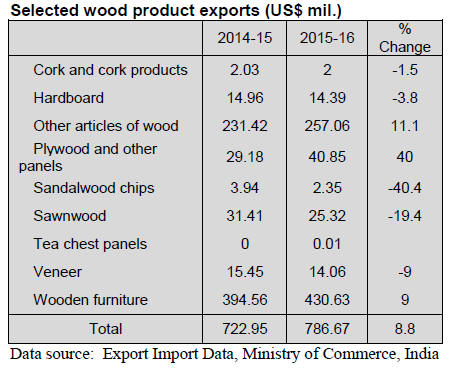
Gurjan plywood facing tough competition
Plywood manufactured by small and medium sized plants
in the so-called &unorganised plywood sector* is facing
tough competition from products manufactured by larger
mills. The smaller mills continue to use gurjan face
veneers, traditionally the preferred timber. However,
plywood faced with poplar or eucalyptus has gained
market share as it is cheaper than gurjan faced panels and
have been accepted by consumers.
Until the log export ban in Myanmar gurjan logs were
readily available at competitive prices but now gurjan face
veneers are being sourced in Laos which has driven up
production costs.
Indian owned mills producing gurjan veneers in Laos
report that the authorities there would prefer to see exports
of plywood rather than low added value veneers but this,
say millers, would increase prices further but that the
Indian market for plywood at present is very competitive
and could not bear a price increase.
CREDAI calls for more loans for home buyers
The Indian Confederation of Real Estate Developers
(CREDAI) has called for relaxing bank lending to boost
housing developments so the sector can contribute more to
the GDP and meet the goal of providing housing for all. At
present the real estate sector in India accounts for only 6%
of the GDP far below levels in other countries.
The problem is, says CREDAI that real estate credit is a
very small percentage of total bank credit on offer. While
this has kept non-performing assets in real estate sector
close to zero it is strangling growth prospects.
CREDAI put the case that priority lending in the housing
sector be increased and that the private sector should be
eligible for slum rehabilitation loans.
See:http://credai.org/assets/upload/news_updates/real-estateindustry-
calls-for-easing-bank-lending-norms-the-times-ofindia.
pdf
Prices for locally sawn hardwoods
As in the previous month the US dollar/Rupee exchange
rate has allowed importers to maintain past price levels.
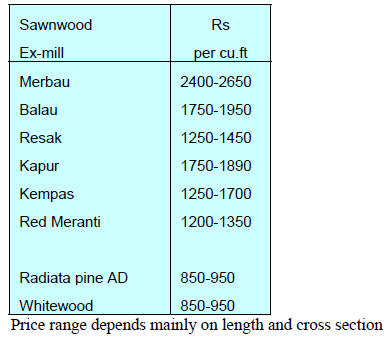
Plantation teak prices
The current pace of deliveries matches demand thus C&F
prices remain stable.

Myanmar teak flitches resawn in India
Ex-mill prices for sawn teak remain unchanged. Imports of
sawn teak from Myanmar have stabilized prices in the
Indian market.
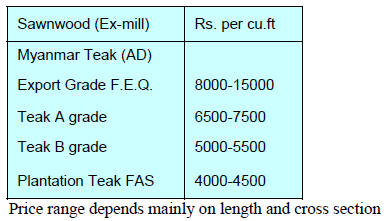
Prices for imported sawnwood
Overall, prices remain unchanged except for American
walnut for which firm demand resulted in an upward
pressure on prices.
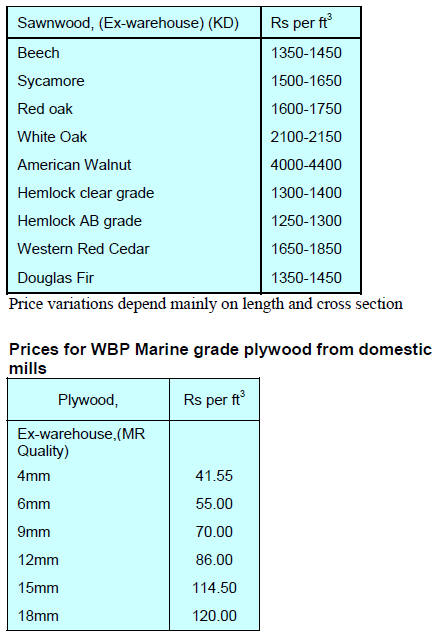

7.
BRAZIL
June tropical sawnwood exports increase
22%
In June 2016 Brazilian exports of wood-products (except
pulp and paper) increased 4.1% in value compared to June
2015, from US$231.7 million to US$241.1 million.
The value of pine sawnwood exports fell 3.9% over the
same period from US$30.9 million to US$ 29.7 million
but, in terms of volume June 2016 exports increased
15.7% year on year from 134,800 cu.m to 156,000 cu.m.
Tropical sawnwood exports increased 22.4% in volume,
from 26,300 cu.m in June 2015 to 32,200 cu.m in June this
year and the value of exports increased 12.3% (US$13
million to US$14.6 million).
June 2016 pine plywood exports increased 2.6% in value
year on year from US$34.1 million to US$35.0 million
and export volumes also increased from 99,600 cu.m to
134,200 cu.m.
A similar trend was seen for tropical plywood exports.
Year on year June exports were up 22.4% in volume from
9,800 cu.m in June 2015 to 12,000 cu.m in June 2016. The
value of exports increased 4.3% from US$4.7 million to
US$4.9 milion over the same period.
Brazil*s wooden furniture exports performed well in June
2106 rising US$35.2 million a year earlier to US$39.5
million.
ABIMCI pushes trade development
During June the Brazilian Association of Mechanically-
Processed Timber Industry (ABIMCI) participated in
several meetings to promote Brazilian wood products.
Meetings were held with representatives from Argentina,
the United States and Japan.
The purpose of the meeting with the representatives from
Argentina was to discuss how to coordinate trade policies
between the two countries so as to facilitate exports. In
particular attention was focused on the need for the
automatic granting of import licenses for wood products.
In anticipation of growth in US demand for wood
products
Brazilian manufacturers foresee opportunities for greater
exports and for investment in the US.
During a meeting with US officials the various incentive
programmes for business investments in the US were
presented including the Select USA programme. (For
more see:
https://www.selectusa.gov/welcome)
This programme aims to attract more businesses to the US
and offers a range of assistance to startup operations such
as business information, research, technical and marketing
advice and networking. In 2015 the United States was the
main market for Brazil*s plywood and sawnwood .
The meeting with JICA and the Japan-Brazil Chamber of
Commerce aimed to expand exports and discussions on
Japanese assistance for the development of wood frame
construction systems suitable for Brazil.
Urgent review of Brazil/Chile maritime agreement
demanded
The Brazilian Tree Industry (IBA) has suggested a review
of the maritime agreement between Brazil and Chile
which has been in force since the 1970s is urgently
required. This agreement gives exclusivity to Chilean and
Brazilian ships for transport of goods between the two
countries but is now outdated and results in shipping costs
being higher than necessary.
At a meeting between representatives of the National
Agency for Waterway Transportation (ANTAQ) and the
Brazilian National Confederation of Industry (CNI)
Brazilian industry representatives pointed out that, due to
the agreement, the cost of shipping between Brazil and
Chile can be higher than shipping to China.
As trade has a major impact on growth, the IBA says it is
necessary to review the agreement for the benefit of both
countries.
Furniture makers search for solutions to overcome
marketing challenges
The 26th MOVERGS Congress held on 30 June in Bento
Gonçalves, Rio Grande do Sul was themed "Renovation -
Attitudes in search for better results". One of the
highlights of the Congress was presentations by speakers
from the Institute for Market Intelligence (IEMI). One
presentation provided an analysis of the national furniture
industry over the past 10 years looking at production,
demand and trends.
The statistics show that economic recession is having a
strong negative impact on the furniture industry and that
the challenge for furniture manufacturers in 2015 was how
to guard against the negative effects of the weak domestic
market.
What emerged from the analysis was that innovation
became the core driver of growth in the sector. To be
successful in this changing consumer behaviour and retail
channels had to be considered.
IEMI pointed out that understanding customer behaviour
is a basic rule in marketing and even more critical when
economic conditions are volatile. IEMI emphasised that
understanding demand drivers and categorising end-users
and their purchasing trends is important.
Entrepreneurs in the furniture sector were encouraged to
abandon the &comfort zone* of past production and
marketing models and rethink their business.
Domestic demand for furniture in Brazil is forecast to
remain depressed throughout the second half of this year
but an improvement should become apparent in 2017.
Economic viability of sustainable forest management
undermined by marketing of illegal timber
A study by Brazil*s Center for Sustainability Studies
(GVces) published in June reports that the economic
viability of Brazilian goal of increasing the area of forest
under sustainable management is closely linked to
addressing competition from illegally sourced wood
products.
Brazil has committed to increase the forest area under
sustainable forest management and to eliminate the
marketing of illegal produced wood products from natural
forests by 2030.
For more see: http://www.gvces.com.br/
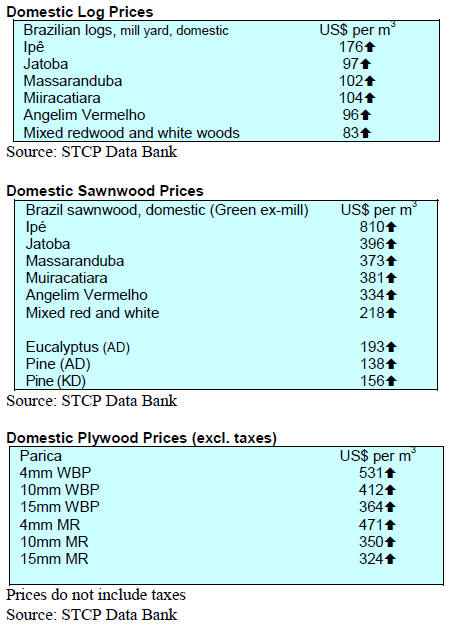
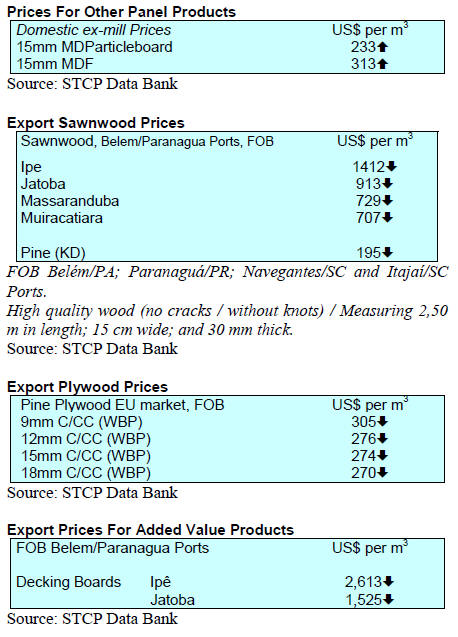
8. PERU
International investment seminar targets
forestry and
timber sectors
AGROBANCO, a state financial institution, charged with
providing credit and financing to micro and small
enterprises in the agricultural and forestry sectors, recently
arranged a seminar on rural microfinance. Themed
"Promoting Forestry Development in Peru" this was for
investors and entrepreneurs from a wide range of
countries. The aim was to encourage private investment in
the forestry sector in Peru and promote the financial
mechanisms on offer from the bank.
The event was attended by over 200 invited
representatives of business, finance and academia who
shared experiences and evaluated business opportunities in
Peru.
Among the international attendees was Alexis Wainer,
founding partner of Trypan (Chile); Glenda Lee, codirector
of Global Terra Latin America; Monarrez Mario
Macias, deputy director of Fisheries, Forestry and
Environment of the Bank of Mexico; Ricardo Luj芍n
Ferrer, director of Forest Brinkman and Associates
Reforestation (Canada).
Other attendees were Martin Sanchez Acosta, editor of
Electronic Bulletin New Forest INTA (Argentina);
Cannaval Robinson, CEO of Innovatech Business Forest
(Brazil); Manoel de Freitas, a forestry expert (Brazil);
Jorge Echeverria Vargas, corporate manager at MASISA
Forestal Forestal (Chile); Luis Enrique Arr谷llaga,
Chairman of the Board of PAYCO (Paraguay); Patricia del
Valle, Forestry and Landuse Unique (Germany); Felipe
Koechlin, executive director of Amazon Reforestadora
(Peru).
Directional felling training in cooperation with GTZ
In order to minimise the impact of logging the German
Technical Cooperation Agency (GTZ) arranged a training
event in the native community of New Irazola on
directional felling for chainsaw operators.
More than twenty chainsaw operators attended and
expanded their skill on the use of chainsaws and
directional felling.The course was conducted by Martin
Winkler and William Pariona, both of GTZ Peru.
Fibreboard imports fall
Between January and May 2016 Peruvian imports of
fibreboard amounted to US$10.24 million, a decline of
almost 5% compared to the same period in 2015. Chile
remained the main supplier despite seeing a 12% decline
in exports to Peru.
Shipments from Brazil increased by 93% to US$ 1.,96
million compared to the same period in 2015. Turkey
remained the third ranked supplier with shipments worth
for US$1,24 million. Arauco Peru was the largest importer
accounting for just over 52% of all fibreboard imports.
Masisa Peru and the Martin Group each imported around
US$1.7 million.
Fibreboard imports by the local subsidiary of Duratex,
Duratex Andina totaled US$434,000 representing around
4% of total fibreboard imports. Duratex is a major
manufacturer of fibreboard in Brazil.
